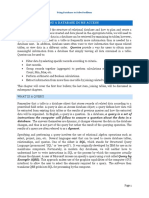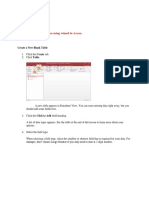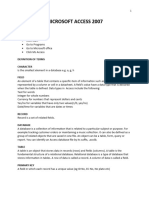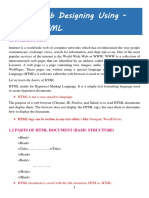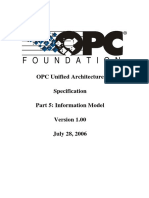CS-IP-Learning-Hub
Important Questions and Notes
Menu
Ch 11 Queries in Libre Office Base NOTES Important Points
July 26, 2024 by csiplearninghub
Share with others
Ch 11 Queries in Libre Office Base NOTES Important Points
Ch 11 Queries in Libre Office Base NOTES Important Points
Introduction
A database is used to store data in an organized manner. Queries are used to retrieve the
desired data easily and accurately from database. In other words we can say that a query is a
sort of question asked from a database.
A query is one of the most important feature of any DBMS. Using a query, we can retrieve and
display data from one or more tables in a database.
LibreOffice Base allows us to create a query and even save it as an object in a database. This
helps us to run the query multiple times as and when required.
Using a query, we can specify the fields that we want to display and also the criterion based on
which the records to be filtered. For example In a Student database, if we want to display the
names and marks of the students in a particular class from the Result table, who have scored
less than 320 aggregate marks.
Queries
A query is to collect specific information from the pool of data. A query helps us to join
information from different tables and filter that information
OR
Queries are commands that are used to define the data structure and also to manipulate the
data in the database.
Creating a Query
A query can be created in three ways. In this chapter we will learn the first two methods to
create a query.
1. Using a Wizard
2. In Design View
3. In SQL view
Creating a Query Using a Wizard
Consider the following table: Table1 (created in database: School)
Rno Name Class Fees
1 Anil X 2500
2 Anuj XI 3000
3 Ashish XII 3200
Let us create a query that will display Roll number, Name, Class from table “Table1” whose Roll
number is 3.
To create a query using a wizard, follow the following steps.
1. Open the School database. Click on Queries button present in the Database Pane.
2. In the Tasks Area, click on Use Wizard to Create Query… option
3. The Query Wizard will open.
Query Wizard
4. Select the required table and then select the required fields(Name, Class and Rno) from the
“Available fields” window to “Field in the Query” window and click on Next Button.
Query Wizard Field Selection
NOTE: Clicking on >> button moves all fields to “Fields in the Query” area.
6. Select the ascending or descending order of any particular field of the table. Since we do
not want to set in a particular order, so we click on Next button.
7. The next step is to set the search conditions or the criteria on the basis of which records will
be filtered from the table.
Query wizard criteria
NOTE: Since we want to display the detail of student having roll number 3 so we set roll
number as 3 in above step
9. Steps 4, 5 and 6 given in the Steps Pane are not required if there is no numeric field
involved in the query. So skip these steps.
10. The next step to give alias name i.e. the column header name will be displayed when we
run the query. Click on Next after writing alias name.
Query Wizard Alias
NOTE: By default the field names will be displayed as column headers. Some times field names
are not user friendly, so an alias name which is more readable is required. For example change
the default field name Rno to Roll Number.
11. The last step of the Query wizard displays the entire overview of the query.
Libre Office Base Query Wizard Overview
12. Click on Finish button.
NOTE:
1. Once the query is created, it can be edited in Design view.
NOTE: Last Step of Query Wizard includes the following (Query Wizard Overview).
Name of the Query – By default, the name of the query is Query_Table1.
The action to be performed after the wizard finishes – By default Display Query option will be
selected. Click and select the Modify Query radio button if the query has to be edited in the
Design view.
Complete detail of the query – This section contains a summary about the query that has been
created.
Creating a Query in Design View
Another way to create a query is using the Design view. This is a more flexible method.
Consider the following table: Table1 (created in database: School)
Rno Name Class Fees
1 Anil X 2500
2 Anuj XI 3000
3 Ashish XII 3200
Let us create a query that will display Roll number, Name, Class from table “Table1” whose Roll
number is 3
1. Click Queries icon on the Objects Pane in the Database Window.
2. Click Create Query in Design View… icon in the Tasks Pane. The Query Design Window
appears. In the middle of the window the Add Table or Query dialog box is displayed as shown
below
Query Design View
3. Click on the “Table1” table to be used in the query and then click on Add Button.
Alternatively double click on the “Table1” table.
4. Click Close button in the Add Table or Query dialog box to close it.
5. Next step is to select the fields. For our query we want to display Roll number, Name and
Class. So in the list box of “Table1” table, double click on the required field.
NOTE: Observe that the Visible Check Box is by default selected. This means that all these
three fields will be visible when you run the query. In the grid, there is a row titled Alias. It can
be used to display meaningful names in the output. For example, instead of Rno, we would just
like to display Roll Number.
To sort the records in either ascending or descending order of a particular field, the Sort row is
given in
the grid. Select ascending or descending from the drop down of Sort row.
6. Write 3 in Criteria row below the Roll number Column.
Query Design-View
NOTE: Once the query is designed, click Run Query ( ) button on the toolbar or press F5 key.
The query result will be displayed in the Tables Pane area.
7. Click on Save button to save the query.
NOTE: By default, the name of the Query is Query1. To run the query again, double click on the
query name. To close the Query window, click on on close button on the top right corner of the
window.
Editing a Query
1. Right click on the Query Name Which you want to edit in the Objects Area of the Database
window.
2. Select Edit option from the drop down menu. The Query Design window will be displayed.
3. Make the required changes like change the Alias, apply criteria or edit the existing criteria
etc.
4. Click on Save and close the Query window.
Working with Numerical Data
Consider the following table: Table1 (created in database: School)
Rno Name Class Fees
1 Anil X 2500
2 Anuj XI 3000
3 Ashish XII 3200
Let us create a query that will display maximum fees from the table “Table1”.
1. In the Database Window, click Create Query in Design View… button to open the Query
Design Window.
2. Select the required field. For our query we want to display Fees. So in the list box of
“Table1” table, double click on the required field.
3. Select the function “Maximum” from the drop down list of functions under “Fees” Column
as shown below.
Design Query using Function
4. Press F5 to run the query.
SUMMARY
• A query is used to retrieve and display data from one or more tables in a database.
• A specific search criteria is given to the DBMS to view the desired information.
• The result of the query is displayed in tabular form with field names in columns and the
records in rows.
• A query can be created in three ways.
■ Using a Wizard
■ In Design View
■ In SQL view
Important links of Class X (IT – 402)
Unit 1: Digital Documentation (Advanced) using LibreOffice Writer
Chapter 1. Introduction to Styles – NOTES
Chapter 1. Introduction to Styles – Question Answers
Chapter 2. Working with Images – NOTES
Chapter 2. Working with Images – Question Answers
Chapter 3. Advanced features of Writer – NOTES
Chapter 3. Advanced features of Writer – Question Answers
Unit 2: Electronic Spreadsheet (Advanced) using LibreOffice Calc
Chapter 4. Analyse Data using Scenarios and Goal Seek – NOTES
Chapter 4. Analyse Data using Scenarios and Goal Seek – Question Answers
Chapter 5. Using Macros in Spreadsheet – NOTES
Chapter 5. Using Macros in Spreadsheet – Question Answers
Chapter 6. Linking Spreadsheet Data – NOTES
Chapter 6. Linking Spreadsheet Data – Question Answers
Chapter 7. Share and Review a Spreadsheet – NOTES
Chapter 7. Share and Review a Spreadsheet – Question Answers
Unit 3: Database Management system using LibreOffice Base
Chapter 8. Introduction to DBMS – NOTES
Chapter 8. Introduction to DBMS – Question Answers
Chapter 9. Starting with LibreOffice Base – NOTES
Chapter 9. Starting with LibreOffice Base – Question Answers
Chapter 10. Working with Multiples Tables – NOTES
Chapter 10. Working with Multiples Tables – Question Answers
UNIT 1: DIGITAL DOCUMENTATION (ADVANCED) – MCQ
UNIT-2: ELECTRONIC SPREADSHEET (ADVANCED) – MCQ
UNIT-3 RELATIONAL DATABASE MANAGEMENT SYSTEMS (BASIC) – MCQ
Disclaimer : I tried to give you the simple Notes of “Ch 11 Queries in Libre Office Base NOTES
Important Points“, but if you feel that there is/are mistakes in the Notes of “Ch 11 Queries in
Libre Office Base NOTES Important Points“ given above, you can directly contact me at
csiplearninghub@gmail.com. NCERT Book and Study material available on CBSE Website are
used to create above article “Ch 11 Queries in Libre Office Base NOTES Important Points“ All
the screenshots used in above article “Ch 11 Queries in Libre Office Base NOTES Important
Points“ are taken from NCERT book.
Ch 11 Queries in Libre Office Base NOTES Important Points
Ch 11 Queries in Libre Office Base NOTES Important Points
Ch 11 Queries in Libre Office Base NOTES Important Points
Ch 11 Queries in Libre Office Base NOTES Important Points
Ch 11 Queries in Libre Office Base NOTES Important Points
Ch 11 Queries in Libre Office Base NOTES Important Points
Ch 11 Queries in Libre Office Base NOTES Important Points
Ch 11 Queries in Libre Office Base NOTES Important Points
Ch 11 Queries in Libre Office Base NOTES Important Points
Ch 11 Queries in Libre Office Base NOTES Important Points
Ch 11 Queries in Libre Office Base NOTES Important Points
Like this:
Loading...
Related
Ch 9 Starting with LibreOffice Base Notes Ch 11 Queries in LibreOffice Base Class Ch 12 Forms and Reports Class 10
Important Points 10 IT-402 NOTES Important Points
Share with others
Class 10 IT Notes
Class 10 IT Notes, IT 402 Class 10
Ch 10 Working with Multiple Tables Question Answers
Ch 11 Queries in LibreOffice Base Class 10 IT-402
Leave a Reply
Subscribe to Blog via Email
Enter your email address to subscribe to this blog and receive notifications of new posts by email.
Email Address
Subscribe
Join 370 other subscribers
About me
I am a teacher with more than 19 years of experience in education field. You can contact me at
csiplearninghub@gmail.com
Like For Update
Recently Added
Ch-2 Working with Images Class 10 Important MCQ March 6, 2025
Ch-3 Advanced Features of Writer Class 10 MCQ January 29, 2025
Class 11 Ch 4 NCERT Problem Solving Questions December 26, 2024
Class 11 Ch 4 Introduction to Problem Solving Notes Important Points December 17, 2024
Class 11 Encoding Schemes Notes: Important Points December 11, 2024
Class 9 IT Sample Paper 2024-25 Important for Exam December 9, 2024
Class 11 Number System Notes: Important Points December 6, 2024
Class 11 IP Ch 8 SQL Introduction NOTES Important Points December 2, 2024
Archives
Select Month
Select Topic
Artificial Intelligence Class 10 (4)
Assignment (3)
Binary File Handling (2)
Case Study Based (2)
Class 10 IT 402 QnA (59)
Class 10 IT Notes (20)
Class 11 Chapter wise MCQ (6)
Class 11 CS Notes (7)
Class 11 IP Notes (1)
Class 12 Chapter wise MCQ (10)
Class 12 CS Notes (1)
Class 12 IP Notes (5)
Class 9 IT 402 QnA (21)
Class 9 IT Notes (8)
CS Sample Paper (2)
Error Finding Questions (1)
File Handling (11)
IT-402 Book Solution (15)
IT-402 Practical (1)
IT-402 Sample Paper (10)
List in Python (5)
MySQL (6)
NCERT CS Solution (13)
NCERT IP Solution (7)
Networking (3)
One Mark Question (12)
Online Quiz (5)
Pandas (9)
Practical Paper Class 12 (2)
Python Conditional Statement Test (1)
Python Data Structure (2)
Python Dictionary (4)
Python Examples (8)
Python Fundamental Test Series (1)
Python Loop Test Series (35)
Python loops Practice Questions (1)
Python Modules (2)
Python Output based questions (2)
Python String (8)
Random in Python (2)
Review of Python (2)
Sample Paper IP (4)
Solved Test (2)
Sorting algorithm (4)
Sumita Arora Solution Class 11 (1)
Tuples in Python (2)
Contact Form
Name *
First Last
Email *
Comment or Message *
� Submit
Search …
Recently Added
Ch-2 Working with Images Class 10 Important MCQ
Ch-3 Advanced Features of Writer Class 10 MCQ
Class 11 Ch 4 NCERT Problem Solving Questions
Class 11 Ch 4 Introduction to Problem Solving Notes Important Points
Class 11 Encoding Schemes Notes: Important Points
Share your Valuable Feedback
Name *
First Last
Email *
Comment or Message *
Submit
Select Topic
Artificial Intelligence Class 10 (4)
Assignment (3)
Binary File Handling (2)
Case Study Based (2)
Class 10 IT 402 QnA (59)
Class 10 IT Notes (20)
Class 11 Chapter wise MCQ (6)
Class 11 CS Notes (7)
Class 11 IP Notes (1)
Class 12 Chapter wise MCQ (10)
Class 12 CS Notes (1)
Class 12 IP Notes (5)
Class 9 IT 402 QnA (21)
Class 9 IT Notes (8)
CS Sample Paper (2)
Error Finding Questions (1)
File Handling (11)
IT-402 Book Solution (15)
IT-402 Practical (1)
IT-402 Sample Paper (10)
List in Python (5)
MySQL (6)
NCERT CS Solution (13)
NCERT IP Solution (7)
Networking (3)
One Mark Question (12)
Online Quiz (5)
Pandas (9)
Practical Paper Class 12 (2)
Python Conditional Statement Test (1)
Python Data Structure (2)
Python Dictionary (4)
Python Examples (8)
Python Fundamental Test Series (1)
Python Loop Test Series (35)
Python loops Practice Questions (1)
Python Modules (2)
Python Output based questions (2)
Python String (8)
Random in Python (2)
Review of Python (2)
Sample Paper IP (4)
Solved Test (2)
Sorting algorithm (4)
Sumita Arora Solution Class 11 (1)
Tuples in Python (2)
© 2025 CS-IP-Learning-Hub • Built with GeneratePress










